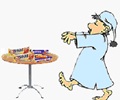Ambien is produced and marked by Sanofi-Aventis. It is one of the leading insomnia drug companies.
Ambien is produced and marked by Sanofi-Aventis. It is one of the leading insomnia drug companies. But at present it is in great trouble as its drug is going to go off-patent this October. There's a range of insomnia drugs on the market, and more are on the way. This is a great relief for some of the people who depend on Ambien for a good night’s sleep.
Good news has been in short supply for the French pharmaceutical company of late. A string of media reports recently highlighted the links between Ambien and sleepwalking, binge eating, and even dangerous nighttime driving.The side effects though already known and mentioned on the product label are attracting increased attention. It’s just a matter of time before cheaper generic versions of insomnia drugs hit the market. Sanofi-Aventis is hoping to withstand some of the threat. Ambien has the lion's share of the $2 billion prescription insomnia drug market.
Sepracor's Lunesta, available since last April, accounts for about 10%. The drug raked in $329.2 million in its first few months. According to National Sleep Foundation (NSF) it was found that 6 out of l0 people approximately about 126 million people experience at least one symptom of insomnia a few nights a week.
But at present Ian Anderson, an analyst at Cowen & Co, says that only 16% of the patient population is being treated with drug therapy. He also predicts that the market would grow up to 30% this year. Indiplon, created by Pfizer and Neurocrine Biosciences is expected to hit the markets this autumn but their approval by the Food & Drug Administration is pending.
The drug will come in two forms. The short-acting version is meant to help treat jetlag and other short-term sleep needs, such as waking up in the middle of the night. Indiplon's relatively short half-life reduces the hangover-like effect, particularly for people who use the drug in the middle of the night.
But Ambien and Lunesta both have longer half-lives, so they are typically not used as middle-of-the-night solutions. But the drug companies have recently asked each other not to begin TV and print advertising of new prescription medicine until physicians have had at least six months to learn more about them.
Advertisements











